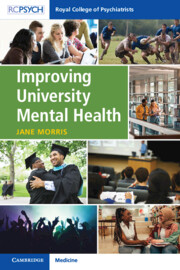Book contents
- Improving University Mental Health
- Improving University Mental Health
- Copyright page
- Contents
- Foreword
- Acknowledgements and Thanks to Contributors
- Chapter 1 Introducing This Handbook
- Chapter 2 Building a New Sense of Belonging
- Chapter 3 The Transition to University for New Students with Pre-Existing Mental Conditions
- Chapter 4 The Roles of Parents and Carers
- Chapter 5 Healthy Bodies, Body Image Concerns, Eating Disorders
- Chapter 6 Alcohol
- Chapter 7 Substance Misuse
- Chapter 8 Social (and Anti-social) Media
- Chapter 9 Finance and Mental Health
- Chapter 10 Neurodiversity
- Chapter 11 Ethnically Diverse University Communities
- Chapter 12 Sexual Behaviour and Gender Identity in Universities
- Chapter 13 The Mental Health of Teaching and Academic Staff
- Chapter 14 An Overview of Mental Disorders in Students and Staff
- Chapter 15 ‘Psychotic’ Disorders
- Chapter 16 Mood Disorders
- Chapter 17 Suicide at University
- Chapter 18 Mental Health Services on Campus and in the NHS
- Chapter 19 Students of the Professions and ‘Fitness to Practise’ Issues
- Chapter 20 Summing It All Up
- Index
- References
Chapter 2 - Building a New Sense of Belonging
The Transition from School to University
Published online by Cambridge University Press: 08 February 2024
- Improving University Mental Health
- Improving University Mental Health
- Copyright page
- Contents
- Foreword
- Acknowledgements and Thanks to Contributors
- Chapter 1 Introducing This Handbook
- Chapter 2 Building a New Sense of Belonging
- Chapter 3 The Transition to University for New Students with Pre-Existing Mental Conditions
- Chapter 4 The Roles of Parents and Carers
- Chapter 5 Healthy Bodies, Body Image Concerns, Eating Disorders
- Chapter 6 Alcohol
- Chapter 7 Substance Misuse
- Chapter 8 Social (and Anti-social) Media
- Chapter 9 Finance and Mental Health
- Chapter 10 Neurodiversity
- Chapter 11 Ethnically Diverse University Communities
- Chapter 12 Sexual Behaviour and Gender Identity in Universities
- Chapter 13 The Mental Health of Teaching and Academic Staff
- Chapter 14 An Overview of Mental Disorders in Students and Staff
- Chapter 15 ‘Psychotic’ Disorders
- Chapter 16 Mood Disorders
- Chapter 17 Suicide at University
- Chapter 18 Mental Health Services on Campus and in the NHS
- Chapter 19 Students of the Professions and ‘Fitness to Practise’ Issues
- Chapter 20 Summing It All Up
- Index
- References
Summary
This, the first of two chapters on the transition from school and home to university, addresses general principles of the nature of transitions. All significant transitions involve normal healthy grieving what is lost (‘homesickness’), alongside rebuilding helpful structures and finding new relationships. Concepts of ‘thresholders’ and ‘transition aged youth’ are discussed alongside growing evidence that dynamic changes in the adolescent brain and mind continue longer than previously thought. Other life transitions are considered from an interpersonal perspective, acknowledging that parents and other family members simultaneously experience disruptive role transitions when a student leaves the family. Individual differences and diverse backgrounds make it difficult to know how much adult capacity can be realistically expected of new students. A list of ‘readiness skills’ is provided for consideration, without the expectation that these will all be mastered before leaving home and school. The author suggests that university need not be the automatic immediate option for school leavers and discusses benefits of using wider criteria than the purely academic to choose a university. Finally induction courses, summer schools and other ways of preparing for university are discussed. These include the peer expectation of using alcohol to manage the inevitable social challenges.
Keywords
- Type
- Chapter
- Information
- Improving University Mental Health , pp. 4 - 20Publisher: Cambridge University PressPrint publication year: 2024



